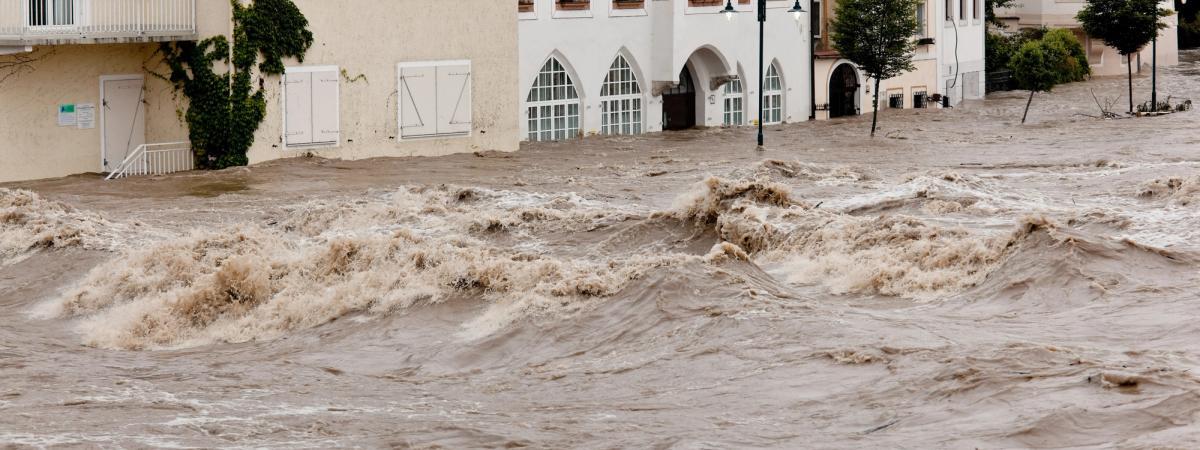
Understanding Commercial Flood Insurance - Do You Need It?
Flooding is the most common natural disaster in the United States. A single inch of floodwater can cause $25,000 in damage to even a modest-sized building.
The problem is that flooding is not covered on a commercial property insurance policy. Due to the frequency, geographic concentration, and high costs of this type of natural disaster, flood policies are only underwritten by government-backed programs (NFIP) and specialty insurance companies. For that reason, purchasing flood insurance isn't as easy as finding a standard property insurance policy for your commercial building.
To help you navigate this challenge, here is everything you need to understand about commercial flood insurance.
Protect Your Property From Flooding
Craft your perfect policy. Request a free quote today.
What is the National Flood Insurance Program (NFIP)?
Following frequent flooding along the Mississippi River in the early 1960s, Congress enacted the National Flood Insurance Act of 1968 to address the lack of flood coverage available in the private insurance market. The NFIP provides services to map flood areas across the U.S., mitigate flood losses, and provide coverage if flooding does occur.
The NFIP is the largest flood insurance writer in the United States and is still the only option for companies located in high-risk flood areas, such as the Gulf, the eastern coast, or near a river or lake.
What is private flood insurance?
As an alternative to the government-backed NFIP insurance program, some insurance companies have started to cherry-pick flood risks in less hazardous areas, offering policies that either competed with the NFIP or covered losses in excess of the NFIP policy's limited coverage amounts ($500,000).
In comparison to the NFIP, private flood markets have more flexibility in the type of coverage and coverage amounts they offer. It is now estimated 16% of flood insurance policies are written through private insurance companies.
What does commercial flood insurance cover?
When determining if you need a commercial flood insurance policy, you first need to understand the water exclusion on the commercial property insurance policy and how it relates to what’s covered under the commercial flood policy.
Types of flooding excluded in a commercial property insurance policy:
Water
(1) Flood, surface water, waves (including tidal wave and tsunami), tides, tidal water,
overflow of any body of water, or spray from any of these, all whether or not driven by wind (including storm surge);
(2) Mudslide or mudflow;
(3) Water that backs up or overflows or is otherwise discharged from a sewer, drain, sump, sump pump or related equipment:
(4) Water under the ground surface pressing on, or flowing or seeping through:
(a) Foundations, walls, floors or paved surfaces;
(b) Basements, whether paved or not; or
(c) Doors, windows or other openings: or
(5) Waterborne material carried or otherwise moved by any of the water referred to in Paragraph (1), (3) or (4), or material carried or otherwise moved by mudslide or mudflow.This exclusion applies regardless of whether any of the above, in Paragraphs (1) through (5), is caused by an act of nature or is otherwise caused. An example of a situation to which this exclusion applies is the situation where a dam, levee, seawall or other boundary or containment system fails, in whole or in part, for any reason, to contain the water.But if any of the above, in Paragraphs (1) through (5), results in fire, explosion or sprinkler leakage, the insurance provider will pay for the loss or damage caused by that fire, explosion or sprinkler leakage.
Types of flooding covered under a commercial flood policy:
Flood, as used in this flood insurance policy, means:
1. A general and temporary condition of partial or complete inundation of two or more acres of normally dry land area or of two or more properties (one of which is your property) from:
a. Overflow of inland or tidal waters;
b. Unusual and rapid accumulation or runoff of surface waters from any source;
c. Mudflow.
2. Collapse or subsidence of land along the shore of a lake or similar body of water as a result of erosion or undermining caused by waves or currents of water exceeding anticipated cyclical levels which result in a flood as defined in A.1.a. above.Although worded a little differently, you can see that a commercial flood policy covers a substantial part of what is excluded on the commercial property insurance policy.
Why do businesses purchase flood insurance?
Lender Requirements
One of the primary reasons people reach out to us for commercial flood insurance is that banks often require it if they are financing a property located in a flood zone. Banks will seek to protect their loan collateral from flood damage.
Business Property Protections
Another reason why property owners often purchase flood insurance is to protect their property from expensive damage. Flood damage often extends beyond just water damage—debris, mud, and trash often cause additional harm that’s very costly to repair.
Private Flood Vs. NFIP (Government-Backed)
Now that you know what types of damage commercial flood insurance covers, your next decision will be whether to purchase flood insurance from the federal government (NFIP) or from a private insurance company (private flood). Each option has its pros and cons, but in general, they are similar forms of insurance. Here is a summary:
NFIP Pros
- Coverage for flood-prone areas - One of the primary benefits of the NFIP program is that you can purchase insurance in flood-prone areas where private insurance companies will not insure.
- Government-backed policies - A government-backed insurance policy is more stable than one backed by a private company. The government has access to more resources and the ability to pay for catastrophes.
- Limited renewal rate increases - Unlike private insurance companies, which can increase or decrease rates in any fashion they see fit, the NFIP can only increase your rate 18% per year. With a rate increase cap, you have more stability if your area were to repeatedly get hit with flooding.
NFIP Cons
- Subject to congressional renewal - Although we mentioned that the government has more resources to pay out flood claims, the NFIP is sometimes caught in political debates about the national budget. Although this does not affect claim payments, the program budget runs the risk of not passing every couple of years, which will result in non-renewals for NFIP policy holders.
- Maximum building and contents limits of $500,000 each on commercial properties - The NFIP does not insure limits higher than $500,000 for commercial buildings and $500,000 for commercial contents. For many property owners, this does not cover the entire building (or even a fraction of it). There’s a solution that we’ll discuss below, but the limits are absolutely a downside of purchasing flood insurance through the NFIP.
- Expensive for those who want flood coverage but are not in a high-risk area - The NFIP is great for commercial buildings in high-risk areas, but for buildings located in areas with a very low risk of flooding, there are lower cost alternatives in the private market.
- 30-day waiting period – After you purchase a flood policy, you have to wait 30 days before the coverage goes into effect. Congress increased the waiting period from 5 days to 30 days in the ’90s to keep property owners from purchasing flood insurance right before a flood. Please note that if you are purchasing flood insurance due to a lender requirement, the 30-day waiting period can be waived.
Private Flood Pros
- Higher limits - The NFIP caps the amount of insurance provided to $500,000 per building, whereas private insurance companies can offer whatever limit they choose. This makes private policies a better option for many property owners since you can obtain flood coverage for the entirety of your building, and not just the first $500,000 in losses.
- Better coverage (replacement cost, business income, extra expense, ordinance & law) - Since private insurance companies can offer any policy terms they want, they often include coverages that are not found on the NFIP policy. For example, a private flood policy could offer replacement cost (cost new) instead of actual cash value (depreciated value); business income (pays for net income while your business is recovering); and ordinance & law (upgrades your damaged building to meet code requirements).
- Non-mandatory elevation certificate - Since private insurance companies operate on their own underwriting guidelines, many flood insurance providers do not require that you provide an elevation certificate (depending on the area of your building).
- Broad coverage (comparable to the NFIP) – While not definitive, private flood policies generally cover everything an NFIP policy would, PLUS additional coverages. The policies are structured this way to incentivize lenders to accept private flood policies for their property loans.
- No Homeowner Flood Insurance Affordability Act of 2014 (HFIAA) fee - When purchasing an NFIP policy, you usually have to pay a fee of approximately $250 to increase your cost of insurance.
- Cheaper for those not located in flood-prone areas - Private flood insurance companies try to cherry-pick the best risks (buildings least likely to flood) from the NFIP program and write the coverage on the least risky properties. They do this by offering cheaper rates than the NFIP on properties with very little chance of flooding.
- 10-day waiting period - Unlike the NFIP, which requires that you purchase a flood policy 30 days before coverage takes place, private insurance companies normally offer a 10-day waiting period.
Private Flood Cons
- Can be canceled or non-renewed - Private flood insurance policies can be non-renewed for a variety of reasons, while NFIP policies do not have the same uncertainty. Yes, NFIP can get defunded from the federal budget, but in general, NFIP policies cannot get non-renewed.
- Subject to rate increases - Private insurance companies can adjust their rates based on risk and claims data. There is no limit to the amount they can adjust their rate, whereas the NFIP can only increase its rate by 18% each year.
- Insurers can leave the market - Private insurance companies can non-renew all their policies in certain zip codes or stop writing flood coverage entirely. The NFIP does not enjoy the same flexibility that private insurers have and cannot exit the market or certain areas of the United States.
- Private isn't available or is more expensive in high-risk areas - It is usually the goal of private flood insurance companies to insure the lower hazard properties; thus private insurance companies either won’t quote in flood-prone areas or are prohibitively expensive.
Different Types Of Private Flood Policies
Choosing between government and private flood insurance isn’t the only decision you have to make. There are also different types of policies commercial flood insurance is written on: stand-alone, difference in conditions, commercial property policy, and excess flood.
Stand-Alone Policy (Private or NFIP)
Whether it is from a private insurance company or the NFIP, a stand-alone flood policy is one of the most common ways that businesses purchase flood insurance. It is not attached to or bundled with any other policy, and is a complete policy to cover the flood peril.
Difference In Conditions Policy (Private)
A DIC policy is an insurance policy that works in conjunction with your primary commercial property policy. Think of a DIC policy as buying back an exclusion on your normal building insurance. Although it isn't a flood policy per se, DIC fills in coverage gaps on a property policy (i.e. buying back flood coverage).
Most commonly, a DIC policy covers flood and earthquake risks, but it can also cover other perils, such as cyber security, or can be customized to cover almost anything if agreed upon by both the insurance company and customer.
Commercial Property Policy With Flood Coverage (Private)
Some private insurance companies have started to offer limited flood coverage on the commercial property insurance policy. Usually there is a small limit, but having the inclusion is very convenient and much lower in cost than other options. If you aren't looking for a flood policy with large limits and the broadest available coverage, this can be a fantastic option.
Excess Flood Policy (Private)
As mentioned earlier in this post, the NFIP policy will only insure the first $500,000 of any commercial building. Also, many private flood insurance companies have limits on what they can quote.
An excess flood policy starts at the limit of your primary flood policy. For example, if you purchased an NFIP policy with the $500,000 limit but have a $2,000,000 building, an excess flood policy can sit on top of the NFIP policy and cover the $500,000 to $2,000,000 damage range.
What is not covered by commercial flood insurance?
Basements Or Below-Ground Property
In general, basements and areas that are below ground are not covered under flood insurance policies. If you live in an area susceptible to flooding, you should not have expensive equipment or property in the basement, such as a server room.
Moisture & Mold Damage Arising From Property Neglect
A commercial flood policy is intended to cover the damage caused by flooding, not damage resulting from neglecting your property.
Outdoor Property
Most flood insurance policies do not cover outdoor property of any kind, such as signs, playgrounds, monuments, trees, etc. If you have significant value tied up in property that resides outdoors, you should talk to an insurance broker to see what can be covered and what is uninsurable.
How much is flood insurance?
How flood insurance is calculated depends on a few factors: the physical construction of your building (wood, steel, concrete, etc.), the flood zone your building is located in, and the value of your building.
Together, these factors will determine the pricing of your commercial flood insurance policy. In a low-risk flood area, we have seen policies start at $400 per year; with larger buildings in a flood zone, we have seen policies exceed $50,000.
If you need a quick ballpark estimate on the premium amount of a flood policy for a smaller commercial building, we can provide that in as little as 5 minutes. Just give us a call and say you are looking for a commercial flood estimate.
Summary
Coverage for flood damage is a massive gap that the standard commercial property insurance policy does not address. Not only is flooding the most common natural disaster in the United States, it is also one of the costliest types of damage your building can have.
If you need help finding a flood policy or want to look into alternatives to the National Flood Insurance Program, let us know. We can help you find options and choose the one right for your business.

About The Author: Austin Landes, CIC
Austin is an experienced Commercial Risk Advisor specializing in property & casualty risk management for religious institutions, real estate, construction, and manufacturing.
THE INFORMATION ON THIS WEBSITE IS PROVIDED FOR INFORMATIONAL PURPOSES ONLY. Nothing on this website should be construed as a solicitation, proposal, offer, recommendation, endorsement, or advice regarding any insurance product. The information on this website is of a general nature and is not intended as a substitute for individual consultation with a licensed insurance professional. In no event will we undertake to advise you regarding your need for any insurance product. YOU ARE RESPONSIBLE FOR DETERMINING WHAT INSURANCE PRODUCTS YOU NEED AND IN WHAT AMOUNTS, BASED ON YOUR UNIQUE EXPOSURE TO RISKS AND ABILITY TO BEAR LOSSES. We are licensed insurance brokers in the following states: WA, OR, ID, MT, WY, CA, NV, UT, AZ, CO, MN, SD, NE, KS, OK, TX, IA, MO, AR, LA, WI, IL, KY, TN, MS, IN, GA, FL, OK, VA, NC, SC, DE, MD, DC, NJ, CT, RI, VT, NH, PA, and ME. Insurance products and features are subject to underwriting criteria and may not be available in all states.
